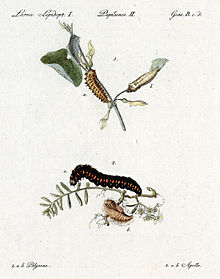Jacob Huebner
Jacob Hübner (born June 20, 1761 in Augsburg ; † September 13, 1826 there ; also: Jakob Hübner ) was a German entomologist of international standing, as well as an engraver .
Life
After attending the St. Anna drawing school for two years, Jacob Hübner completed an apprenticeship in etching and shaping from 1778 to 1780 . This training was an important prerequisite for his job as a draftsman in a calico factory in Augsburg. At the same time it was an essential basis for his scientific work.
Hübner's first public work appeared in 1785 with copperplate engravings of previously largely unknown butterflies. This work already made clear Huebner's good knowledge of species and literature. Hübner received important impulses for the aim of his scientific work during a stay in Vienna from August 1788 to spring 1789. Here he met Ignaz Schiffermüller (1727–1806), with whom he remained on friendly terms throughout his life. Professionally, Hübner worked as a draftsman in the textile industry. At the same time he created his lepidopterological work, which made him famous in specialist circles while he was still alive. His immense work was mainly created as a part-time job. He self-published most of his publications. Hübner's estate was acquired by the Royal Entomological Society of London in 1935 .
Works (selection)
- 1785: Illustrations and descriptions of not yet shown and not yet described butterflies with illuminated coppers
- 1786–1790: Contributions to the history of butterflies doi: 10.5962 / bhl.title.65313
- 1791: List of European butterflies according to a systematic order using synonyms, images and notes
- 1793: Collection of selected birds and butterflies, published with their names on one hundred coppers painted from nature
- 1793– [1842]: History of European butterflies doi: 10.5962 / bhl.title.65797
- 1796– [1838]: Collection of European butterflies doi: 10.5962 / bhl.title.39974
- 1806– [1838]: Collection of exotic butterflies doi: 10.5962 / bhl.title.11544
- 1806: Tentamen doi: 10.5962 / bhl.title.11651
- 1816: List of known butterflies . doi: 10.5962 / bhl.title.48607
- 1818–1837: Contributions to the collection of exotic butterflies . doi: 10.5962 / bhl.title.12439
- 1822: Systematic-alphabetical index of all generic names mentioned so far in the formations for the collection of European butterflies doi: 10.5962 / bhl.title.48605
- 1843–1856: Systematic processing of the butterflies of Europe . doi: 10.5962 / bhl.title.67734
Jacob Huebner's importance
Hübner's biography is remarkable in several respects. As the son of a former “Habnit” (= day laborer), he worked his way up to become a nationally known natural scientist. In his hometown Augsburg, which has large butterfly collections and an important private scientific library, he is the first recognized expert in his field of research. Hübner's outstanding importance as an illustrator and scientist was already recognized by his contemporaries. On 1952 copper plates, Hübner depicts a total of 3598 butterfly species "in the most faithful imitation of nature", 1500 of them for the first time. The History of European Butterflies contains 500 panels with 734 species, the European Butterflies Collection 789 panels with 2627 species, and the Exotic Butterflies Collection 663 panels with 971 species. Th. A. Wohlfahrt wrote about Hübner's illustrations in 1978: "... his copper plates, which he himself engraved and painted, are, as it were, a homage to a species in which the exactness and artistic cohesion are almost perfect." which in its main features is still important today. Jacob Hübner is next to Christian Friedrich Freyer and the illustrators of the work Conversations from the natural history of Gottlieb Tobias Wilhelm the last important representative of the Augsburg copper engraving trade.
literature
- Wolfgang Dierl: Huebner, Jacob. In: New German Biography (NDB). Volume 9, Duncker & Humblot, Berlin 1972, ISBN 3-428-00190-7 , pp. 720 f. ( Digitized version ).
- F. Hemming: A bibliographical and systematic account of the entomological works of Jacob Huebner . London 1937, 2 volumes, 926 pages
- H. Oblinger: Jacob Huebner . In: University Library Augsburg (Ed.): Gelehrtes Schwaben , 1990, pp. 109–110.
- Eberhard Pfeuffer (Ed.): Fascinated by nature ... Early Augsburg naturalists and their pictures (Jacob Hübner, Gottlieb Tobias Wilhelm, Christian Friedrich Freyer, Johann Friedrich Leu, Jakob Friedrich Caflisch, Andreas Wiedemann). Wißner, Augsburg 2003, ISBN 978-3-89639-392-0
- Jacob Huebner: History of European Butterflies . CD-ROM, with a foreword by E. Pfeuffer, Harald Fischer, Erlangen 2004, ISBN 3-89131-427-2 ( examples )
Web links
- Literature by and about Jacob Huebner in the catalog of the German National Library
Individual evidence
- ↑ a b c supplemented by Carl Geyer and GAW Herrich-Schäffer after Hübner's death
- ↑ H. Oblinger, 1990
- ↑ F. Hemming, 1937
| personal data | |
|---|---|
| SURNAME | Huebner, Jacob |
| ALTERNATIVE NAMES | Huebner, Jakob |
| BRIEF DESCRIPTION | German entomologist |
| DATE OF BIRTH | June 20, 1761 |
| PLACE OF BIRTH | augsburg |
| DATE OF DEATH | September 13, 1826 |
| Place of death | augsburg |


